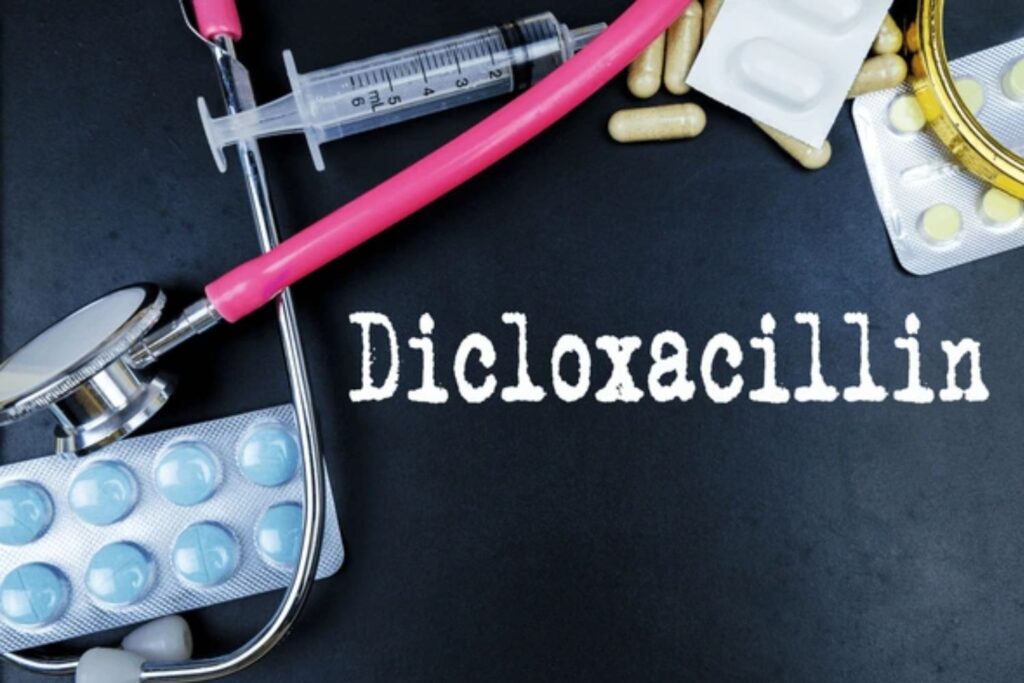
Dicloxacillin is a semisynthetic penicillin designed to fight infections caused by penicillinase-producing staphylococci, especially methicillin-susceptible Staphylococcus aureus (MSSA). As clinicians continue to shift toward targeted antimicrobial strategies, dicloxacillin remains a key oral agent due to its acid stability, high oral bioavailability, and resistance to staphylococcal beta-lactamase.
This article provides a comprehensive review of dicloxacillin’s clinical pharmacology, therapeutic uses, and safety considerations. With PatSnap Eureka AI Agent, pharmaceutical researchers and regulatory strategists can explore clinical trials, resistance data, and IP trends related to dicloxacillin and similar isoxazolylpenicillins.
What is Dicloxacillin?
Dicloxacillin is a narrow-spectrum beta-lactam antibiotic within the penicillinase-resistant penicillins group. It is primarily indicated for the treatment of skin and soft tissue infections caused by beta-lactamase-producing Gram-positive cocci, particularly MSSA. But unlike broader-spectrum antibiotics, dicloxacillin offers the advantage of minimal impact on gut flora and reduced risk of antibiotic resistance development due to its narrow antimicrobial target.

Key Characteristics of Dicloxacillin
| Attribute | Details |
|---|---|
| Drug Class | Penicillinase-resistant β-lactam |
| Spectrum | Narrow (Gram-positive cocci, especially MSSA) |
| Resistance Profile | Stable against penicillinase-producing staphylococci |
| Oral Bioavailability | High; suitable for outpatient treatment |
| CNS Penetration | Limited; not suitable for meningitis |
| FDA Status | Approved for multiple staphylococcal infections |
Key Forms and Formulations
Dicloxacillin is primarily available as:
- Capsules: 250 mg and 500 mg (most common oral form)
- Oral suspension: 62.5 mg/5 mL or 125 mg/5 mL
- IV formulations: Not typically used (oxacillin preferred for IV use)
Mechanism of Action
PatSnap Eureka AI Agent helps reveal how beta-lactam antibiotics exert their antimicrobial activity and how resistance can emerge across different bacterial strains.

Target Binding and Inhibition
Dicloxacillin’s core mechanism revolves around inhibiting the synthesis of the bacterial cell wall—a critical structure for bacterial survival. The drug specifically targets the bacterial wall by binding to penicillin-binding proteins (PBPs). These PBPs are essential enzymes involved in the final stages of peptidoglycan synthesis, the primary component of the bacterial cell wall.
Peptidoglycan Synthesis Disruption
By binding to PBPs, dicloxacillin inhibits two key enzymatic activities: transpeptidation and transglycosylation.
- Transpeptidation forms cross-links between peptidoglycan chains, giving the cell wall structural strength.
- Transglycosylation polymerizes glycan chains, a foundational step in cell wall assembly.
Inhibiting these processes halts the formation of mature peptidoglycan, compromising the bacterial wall’s integrity.
Bacterial Cell Lysis
With a weakened or incomplete cell wall, the bacterium becomes vulnerable to osmotic pressure. Unable to maintain structural integrity, the cell undergoes lysis—resulting in rapid bacterial death.
Spectrum of Activity
Dicloxacillin is particularly effective against Gram-positive bacteria, especially Staphylococcus aureus.
It demonstrates strong activity against methicillin-sensitive S. aureus (MSSA), and was originally developed to combat beta-lactamase-producing strains. While it resists degradation by many beta-lactamases, it is not effective against MRSA, which expresses altered PBPs (e.g., PBP2a) that reduce drug binding.
Resistance Mechanisms
Despite its targeted design, resistance to dicloxacillin may occur via several mechanisms:
- Beta-lactamase production: Although dicloxacillin resists many penicillinases, high levels or certain types can still inactivate it.
- PBP modification: Structural changes in PBPs reduce the drug’s binding affinity, a hallmark of MRSA and other resistant strains.
Summary
Dicloxacillin exerts its antibacterial effects by targeting PBPs and disrupting peptidoglycan cross-linking, leading to cell wall failure and bacterial lysis. Its narrow-spectrum activity and beta-lactamase resistance make it a valuable agent against MSSA infections. However, evolving resistance mechanisms, particularly involving PBPs, remain a clinical concern.

Clinical Uses of Dicloxacillin
Skin and Soft Tissue Infections
- Cellulitis: Dicloxacillin is a first-line treatment for cellulitis caused by S. aureus, including methicillin-sensitive S. aureus (MSSA). It is also used for other Streptococcus isolates.
- Abscesses: Treat cutaneous abscesses, which are often caused by S. aureus.
- Wound Infections: Dicloxacillin is effective for treating wound infections, including those caused by S. aureus.
- Impetigo: Treat impetigo, a superficial skin infection often caused by S. aureus or Streptococcus pyogenes.
Bone and Joint Infections:
- Osteomyelitis: Treat osteomyelitis, an infection of the bone, caused by S. aureus.
- Septic Arthritis: Ttreat septic arthritis, an infection of a joint, caused by S. aureus.
Respiratory Tract Infections:
- Pneumonia: We can use use it to treat pneumonia caused by S. aureus or Streptococcus pneumoniae.
Other Infections:
- Bacteremia/Septicemia: Treat bacteremia or septicemia caused by S. aureus.
- Endocarditis:Treat endocarditis, an infection of the heart valves, caused by S. aureus.
- Mastitis: Treat bacterial mastitis, an infection of the breast tissue, often caused by S. aureus.
Prevention:
- Surgical Prophylaxis: Dicloxacillin can be used for surgical prophylaxis to prevent infections caused by S. aureus, particularly in patients with known colonization or infection.
Dosage and Administration of Dicloxacillin
| Population | Dose | Frequency | Administration Notes |
|---|---|---|---|
| Adults | 250–500 mg | Every 6 hours | Take on an empty stomach |
| Pediatric | 12.5–25 mg/kg/day | Divided in 3–4 doses | Based on infection severity |
| Duration | 7–14 days (typical) | Adjust per infection type and clinical response |
Dicloxacillin should be taken at least 1 hour before or 2 hours after meals to ensure optimal absorption.
Side Effects and Safety
Common side effects include nausea, vomiting, diarrhea, and allergic reactions. Serious side effects include anaphylaxis, Stevens-Johnson syndrome, and toxic epidermal necrolysis. Dicloxacillin is contraindicated in patients with a history of hypersensitivity to penicillins or cephalosporins. It should be used with caution in patients with renal impairment.
Dicloxacillin vs. Other Antibiotics
| Antibiotic | Primary Use | Beta-lactamase Stability | Oral Option | MRSA Coverage | Notes |
|---|---|---|---|---|---|
| Dicloxacillin | MSSA, SSTIs | Yes | Yes | No | Narrow spectrum, oral MSSA agent |
| Amoxicillin | Broad infections, strep, H. pylori | No | Yes | No | Ineffective against penicillinase bacteria |
| Cephalexin | SSTIs, UTIs | Partial | Yes | No | Cephalosporin alternative |
| Clindamycin | SSTIs, anaerobic infections | Yes (non-beta-lactam) | Yes | Variable | Covers anaerobes, but higher C. diff risk |
| Vancomycin | MRSA, serious Gram-positive infections | Yes | IV (oral only for C. diff) | Yes | Reserved for resistant cases |
Drug Interactions
Like other penicillinase-resistant penicillins, dicloxacillin may interact with several drugs through enzyme induction, competition for renal excretion, or alteration of gut flora. These interactions can lead to reduced therapeutic efficacy of co-administered agents or increased plasma concentrations of dicloxacillin.
Warfarin
Dicloxacillin can decrease the anticoagulant effect of warfarin.
- Mechanism: It induces cytochrome P450 enzymes, particularly CYP3A4 and possibly CYP2C9, which are involved in the metabolism of warfarin.
- Consequence: This leads to faster clearance of warfarin, resulting in lower INR values and reduced anticoagulant effect, potentially increasing the risk of thromboembolic events.
- Clinical Note: Patients co-administered dicloxacillin and warfarin should have their INR monitored closely, and dose adjustments may be necessary.
Oral Contraceptives (Estrogen-containing)
Dicloxacillin may reduce the efficacy of hormonal contraceptives.
- Proposed Mechanisms:
- CYP enzyme induction may increase the metabolism of estrogen or progestin components.
- Changes in gut flora may reduce enterohepatic recirculation of estrogens, lowering active hormone levels.
- Clinical Note: Although the clinical significance is debated, it is generally recommended to use backup contraceptive methods during and for at least 7 days after dicloxacillin therapy.
Probenecid
Probenecid can increase the plasma concentration of dicloxacillin.
- Mechanism: It inhibits renal tubular secretion, reducing dicloxacillin excretion via the kidneys.
- Consequence: This results in higher and more sustained serum levels of dicloxacillin.
- Clinical Application: Sometimes used intentionally to enhance beta-lactam antibiotic efficacy by prolonging drug exposure, especially in severe infections. However, this combination should be used with caution and under medical supervision.
Methotrexate (potential)
Although not extensively documented, other penicillins can reduce methotrexate clearance, potentially leading to toxicity. This interaction may apply to dicloxacillin as well and warrants monitoring of methotrexate levels when used concomitantly.

Conclusion
Dicloxacillin plays a crucial role in the treatment of MSSA-related infections, offering a stable, orally active, penicillinase-resistant option for outpatient care. Its narrow spectrum reduces the risk of resistance development and collateral microbiota disruption.
In the context of rising antimicrobial stewardship efforts, drugs like dicloxacillin exemplify targeted therapy with predictable pharmacology and real-world effectiveness.
With PatSnap Eureka AI Agent, healthcare professionals and pharma teams can explore dicloxacillin’s global clinical utility, resistance mapping, competitive IP activity, and lifecycle strategies—ensuring data-driven antibiotic decisions and strategic formulation development.
FAQs
Treat bacterial infections like skin, soft – tissue, and respiratory infections caused by penicillin – resistant Staphylococcus aureus.
Depends on the infection. Dicloxacillin is better for penicillin – resistant Staph aureus; amoxicillin works for broader bugs (e.g., some respiratory, ear infections).
Yes. Common ones: nausea, diarrhea, rash. Rare but serious: allergic reactions, liver issues.
Avoid alcohol (may worsen stomach upset). Don’t skip doses; finish the full course. Tell docs about allergies (esp to penicillins)
To get more detailed scientific explanations of the dicloxacillin, try PatSnap Eureka AI Agent.

